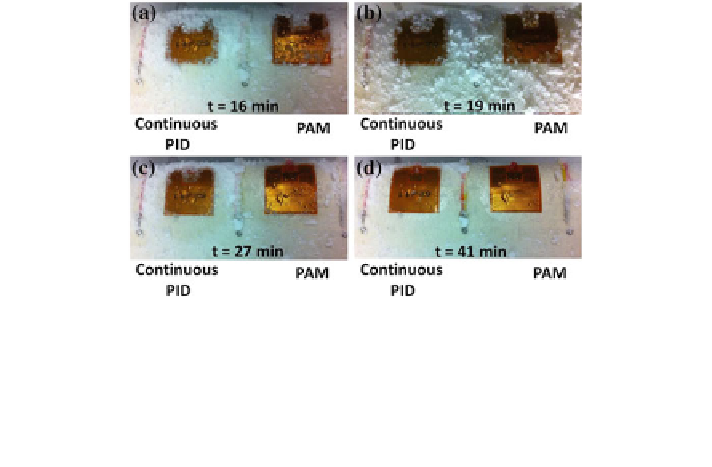Environmental Engineering Reference
In-Depth Information
Fig. 8.26 Visual comparison of low intensity continuous PID actuation versus higher intensity
PAM actuation with the same amount of electrical energy expenditure. The PAM frequency is
0.1 Hz. Over each period, the PAM actuation has a 40 % duty cycle, and a pulse magnitude that
is 1.581 times larger than the continuous PID signal. The icing chamber temperature is slightly
higher than -10 C throughout the test. More rime ice residue can be seen on the heater for the
lower intensity continuous PID control compared to the PAM control at all times. a t = 16 min.
b t = 19 min. c t = 27 min. d t = 41 min
optical ice sensors (and associated signal processing algorithms) in the closed-
loop. In Fig.
8.26
, both of the resistors use the same amount of electrical energy. It
is shown visually that PAM provides better de-icing results and faster thermal
energy propagation through the composite blade. Running several analogous
experiments generated repeatable results.
Figure
8.27
shows the applied voltage and temperature variation for these two
different actuation techniques. It is seen that PAM actuation has a better de-icing
performance than continuous PID control when using the same amount of elec-
trical energy by yielding a higher temperature at the closest thermocouple at all
times. These two temperature sensors are mounted diagonally from the corner of
each resistive heater with the same distance. The improved performance of the
PAM controller is due to a high thermal inertia of the resistive heaters that can
hold the required heat for a while (more than 15 s) even after switching off before
the generated thermal energy is dissipated by convection loss. Further investiga-
tions are needed for different wind speeds and blade pitch angles. These test results
are for a no wind condition (natural convection) and a nonrotating (stationary)
blade where convection loss is normally less compared to a rotating wind turbine
under similar environmental conditions.
8.11 Conclusion
Optical ice sensing and distributed resistive heating have been investigated for
active de-icing of wind turbines. Distributed electrothermal actuation is capable of
locally adjusting the thermal power at different blade locations in order to reduce

